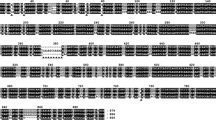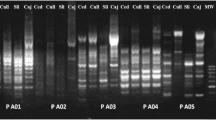Abstract
Several populations of the stem-mining weevil Mecinus janthinus Germar species complex (Mecinini, Curculionidae), identified based on morphological characteristics, have been introduced in North America for the biological control of invasive toadflaxes of European origin: Linaria vulgaris Miller and L. dalmatica (L.) Miller (Plantaginaceae). According to the mitochondrial cytochrome oxidase subunit II (COII) gene haplotype divergence of Mecinus janthinus species complex, a total of 20 M. janthinus s.s., 3 M. janthinus s.l. of the ‘speciosa’ genotype and 29 M. janthiniformis haplotypes have been recorded across their native range in central and southeastern Europe. A polymerase chain reaction followed by restriction fragment length polymorphism (PCR-RFLP) diagnostic assay of COII gene using Hpy188III and MnlI enzyme-mix, was developed for fast and cost-effective discrimination of these morphologically very similar cryptic weevil species. It is shown that digestion generates unique 4-fragment restriction profile in M. janthinus s.s., 2-fragment profile in M. janthiniformis and 3-fragment profile in M. janthinus s.l. ‘speciosa’ group of haplotypes, allowing precise identification of each species or genotype. The proposed method represents a practical tool for fast and accurate identification of the target biocontrol agents and should prevent using inappropriate weevil species in redistribution programs for biological control of invasive toadflax species.


Similar content being viewed by others
References
Barr NB, Copeland RS, De Meyer M, Masiga D, Kibogo HG, Billah MK, Osir E, Wharton RA, McPheron BA (2006) Molecular diagnostics of economically important Ceratitis fruit fly species (Diptera: Tephritidae) in Africa using PCR and RFLP analyses. Bull Entomol Res 96:505–521
Brunner PC, Fleming C, Frey E (2002) A molecular identification for economically important thrips species (Thysanoptera: Thripidae) using direct sequencing and a PCR-RFLP-based approach. Agric For Entomol 4:127–136
Caldara R, Desančić M, Gassmann A, Legarreta L, Emerson B, Toševski I (2008) On the identity of Rhinusa hispida (Brullé) and its current synonyms (Coleoptera: Curculionidae). Zootaxa 1805:61–68
Chater AO, Valdes B, Webb DA (1972) 14. Linaria Miller. In: Tutin TG, Heywood VH, Burges NA, Moon DM, Valentine DH, Walters SM, Webb DA (eds) Flora Europaea, Vol. 3. Cambridge University Press, Cambridge, UK
Davis PH (1978) Flora of Turkey, vol 6. Edinburgh University Press, Edinburgh, UK
De Clerck-Floate RA, Harris P (2002) Linaria dalmatica (L.) Miller, Dalmatian toadflax (Scrophulariaceae). In: Mason PG, Huber JT (eds) Biological Control Programmes in Canada, 1981–2000, CABI Publishing, Wallingford, Oxon, UK, pp 368–374
Emerson BC, Oromi P, Hewitt GM (2000) Interpreting colonization of the Calathus (Coleoptera: Carabidae) on the Canary Islands and Madeira through the application of the parametric bootstrap. Evolution 54:2081–2090
Gaskin JF, Bon MC, Cock MJW, Cristofaro M, De Biase A, De Clerck-Floate R, Ellison CA, Hinz H, Hufbauer R, Julien M, Sforza R (2011) Applying molecular-based approaches to classical biological control of weeds. Biol Control 58:1–21
Hartl D (1974) Familie Scrophulariaceae. In: Hegi G, Hartl D, Wagenitz G (eds) Illustrierte Flora von Mittleleuropa, Bd. VI, Part 1, 2nd edn. Carl Hanser, Munich, Germany
Hernández-Vera G, Mitrović M, Jović J, Toševski I, Caldara R, Gassmann A, Emerson BC (2010) Host associated genetic differentiation in a seed parasitic weevil Rhinusa antirrhini (Coleptera: Curculionidae) revealed by mitochondrial and nuclear sequence data. Mol Ecol 19:2286–2300
Jeanneret P, Schroeder D (1991) Mecinus janthinus Germar (Coleoptera: Curculionidae): a candidate for the biological control of Dalmatian and yellow toadflax in North America. Final report. International Institute of Biological Control, CAB International, European Station, Delemont, Switzerland
Mack RN (2003) Plant naturalizations and invasions in the Eastern United States: 1634–1860. Ann Mo Bot Gard 90:77–90
McClay AS, De Clerck-Floate RA (2002) Linaria vulgaris Miller, yellow toadflax (Scrophulariaceae). In: Mason PG, Huber JT (eds) Biological Control Programmes in Canada, 1981–2000, CABI Publishing, Wallingford, Oxon, UK, pp 375–382
McClay AS, Hughes RB (2007) Temperature and host-plant effects on development and population growth of Mecinus janthinus (Coleoptera: Curculionidae), a biological control agent for invasive Linaria spp. Biol Control 40:405–410
McKern J, Szalanski A (2007) Molecular diagnostics of economically important clearwing moths (Lepidoptera: Sesiidae). Fla Entomol 90:475–479
Niketić M, Tomović G (2008) Taxonomy and nomenclature of the Linaria genistifolia complex (Plantaginaceae–Antirrhineae) in S.E Europe and Anatolia. Taxon 57:619–629
Peterson R, Sing S, Weaver D (2005) Differential physiological responses of Dalmatian toadflax, Linaria dalmatica L. Miller, to injury from two insect biological control agents: implications for decision-making in biological control. Environ Entomol 34:899–905
Rauth JS, Hufbauer AR (2009) PCR-RFLP assays for discerning three weevil stem feeders (Ceutorhynchus spp.) (Col.: Curculionidae) on garlic mustard (Alliaria petiolata). Biocontrol Sci Technol 19:999–1005
Rauth S, Hinz H, Gerber E, Hufbauer R (2011) The benefits of pre-release population genetics: a case study using Ceutorhynchus scrobicollis, a candidate agent of garlic mustard, Alliaria petiolata. Biol Control 56:67–75
Roehrdanz R, Bourchier R, Cortilet A, Olson D, Sears S (2011) Phylogeny and genetic diversity of flea beetles (Aphthona sp.) introduced to North America as biological control agents for leafy spurge. Ann Entomol Soc Am 104:966–975
Salazar M, Theoduloz C, Vega A, Poblete F, González E, Badilla R, Meza-Basso L (2002) PCR-RFLP identification of endemic Chilean species of Rhagoletis (Diptera: Tephritidae) attacking Solanaceae. Bull Entomol Res 92:337–341
Schat M, Sing S, Peterson R, Menalled F, Weaver D (2011) Growth inhibition of Dalmatian toadflax, Linaria dalmatica (L.) Miller, in response to herbivory by the biological control agent Mecinus janthinus Germar. J Entomol Sci 46:232–246
Scheffer SJ, Wijeskara A, Visser D, Hallett RH (2001) PCR-RFLP method to distinguish Liriomyza huidobrensis from L. langei applied to three recent leafminer invasions. J Econ Entomol 94:1177–1182
Sutton DA (1988) A revision of the tribe Antirrhineae. Oxford University Press, London & Oxford, UK
Tamura K, Peterson D, Peterson N, Stecher G, Nei M, Kumar S (2011) MEGA5: molecular evolutionary genetics analysis using maximum likelihood, evolutionary distance, and maximum parsimony methods. Mol Biol Evol 28:2731–2739
Toševski I, Caldara R, Jović J, Hernández-Vera G, Naviera C, Gassmann A, Emerson BC (2011) Morphological, molecular and biological evidence reveal two cryptic species in Mecinus janthinus Germar (Coleoptera, Curculionidae), a successful biological control agent of Dalmatian toadflax, Linaria dalmatica (Lamiales, Plantaginaceae). Syst Entomol 36:741–753
van Hezewijk BH, Bourchier RS, De Clerck-Floate RA (2010) Regional-scale impact of the weed biocontrol agent Mecinus janthinus on Dalmatian toadflax (Linaria dalmatica). Biol Control 55:197–202
Vujnović K, Wein RW (1997) The biology of Canadian weeds. 106. Linaria dalmatica (L.) Mill. Can J Plant Sci 77:483–491
Ward SM, Scott DR, Harrington J, Sutton J, Beck GK (2008) Genetic variation in invasive populations of yellow toadflax (Linaria vulgaris) in the western United States. Weed Sci 56:394–399
Ward SM, Fleischmann CE, Turner MF, Sing SE (2009) Hybridization between invasive populations of Dalmatian toadflax (Linaria dalmatica) and yellow toadflax (Linaria vulgaris). Invasive Plant Sci Manag 2:369–378
Wilson LM, Sing SE, Piper GL, Hansen RW, De Clerck-Floate R, MacKinnon DK, Randall C (2005) Biology and biological control of Dalmatian and yellow toadflax. USDA Forest Service, FHTET-05-13, Morgantown, USA
Acknowledgments
We thank the Ministry of Forests and Range, British Columbia Provincial Government, the Wyoming Biological Control Steering Committee, USDA-APHIS-CPHST, the USDA Forest Service and the Montana Noxious Weed Trust Fund through the Montana State University, and the California Department of Food and Agriculture who supported this programme. We gratefully acknowledge the support of Dr De Clerck-Floate (AAFC, Lethbridge, Canada) and Dr Andrew Norton (Colorado State University, USA), the coordinators of the toadflax consortium in North America. This research was partly funded by Grant III43001 (The Ministry of Education, Science and Technological Development of the Republic of Serbia).
Author information
Authors and Affiliations
Corresponding author
Additional information
Handling Editor: John Scott
Rights and permissions
About this article
Cite this article
Toševski, I., Jović, J., Krstić, O. et al. PCR-RFLP-based method for reliable discrimination of cryptic species within Mecinus janthinus species complex (Mecinini, Curculionidae) introduced in North America for biological control of invasive toadflaxes. BioControl 58, 563–573 (2013). https://doi.org/10.1007/s10526-013-9506-2
Received:
Accepted:
Published:
Issue Date:
DOI: https://doi.org/10.1007/s10526-013-9506-2




